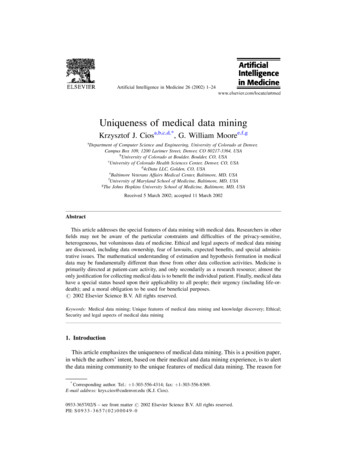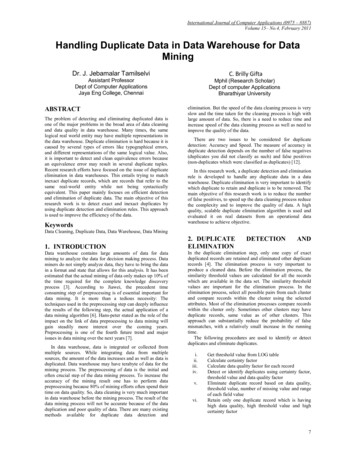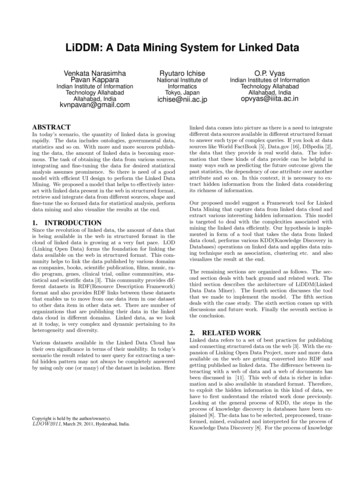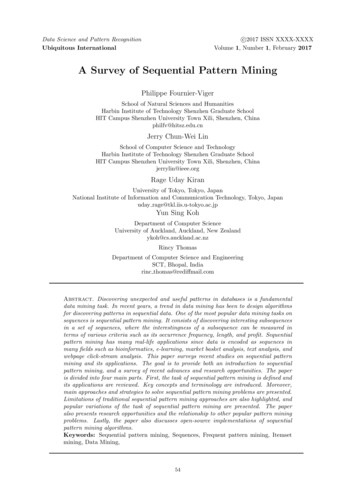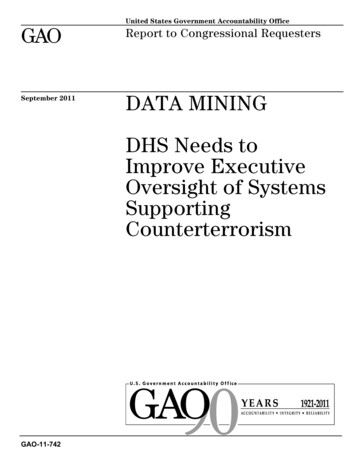
Transcription
United States Government Accountability OfficeGAOReport to Congressional RequestersSeptember 2011DATA MININGDHS Needs toImprove ExecutiveOversight of SystemsSupportingCounterterrorismGAO-11-742
September 2011DATA MININGDHS Needs to Improve Executive Oversight ofSystems Supporting CounterterrorismHighlights of GAO-11-742, a report tocongressional requestersWhy GAO Did This StudyWhat GAO FoundData mining—a technique forextracting useful information from largevolumes of data—is one type ofanalysis that the Department ofHomeland Security (DHS) uses to helpdetect and prevent terrorist threats.While data-mining systems offer anumber of promising benefits, their usealso raises privacy concerns.As part of a systematic evaluation framework, agency policies should ensureorganizational competence, evaluations of a system’s effectiveness and privacyprotections, executive review, and appropriate transparency throughout thesystem’s life cycle. While DHS and three of its component agencies—U.S.Customs and Border Protection, U.S. Immigration and Customs Enforcement,and the U.S. Citizenship and Immigration Services—have established policiesthat address most of these key policy elements, the policies are notcomprehensive. For example, DHS policies do not fully ensure executive reviewand transparency, and the component agencies’ policies do not sufficientlyrequire evaluating system effectiveness. DHS’s Chief Information Officerreported that the agency is planning to improve its executive review process byconducting more intensive reviews of IT investments, including the data-miningsystems reviewed in this report. Until such reforms are in place, DHS and itscomponent agencies may not be able to ensure that critical data mining systemsused in support of counterterrorism are both effective and that they protectpersonal privacy.GAO was asked to (1) assess DHSpolicies for evaluating the effectivenessand privacy protections of data-miningsystems used for counterterrorism, (2)assess DHS agencies’ efforts toevaluate the effectiveness and privacyprotections of their data-miningsystems, and (3) describe thechallenges facing DHS in implementingan effective evaluation framework.To do so, GAO developed a systematicevaluation framework based onrecommendations and best practicesoutlined by the National ResearchCouncil, industry practices, and priorGAO reports. GAO compared itsevaluation framework to DHS’s andthree component agencies’ policiesand to six systems’ practices, andinterviewed agency officials about gapsin their evaluations and challenges.What GAO RecommendsGAO is recommending that DHSexecutives address gaps in agencyevaluation policies and that componentagency officials address shortfalls intheir system evaluations. DHSconcurred with GAO’srecommendations and identified stepsit is taking to address selectedrecommendations. The departmentalso offered technical comments,which GAO incorporated asappropriate.Another aspect of a systematic evaluation framework involves ensuring thatagencies implement sound practices for organizational competence, evaluationsof a system’s effectiveness and privacy protections, executive review, andappropriate transparency and oversight throughout a system’s life cycle.Evaluations of six data mining systems from a mix of DHS component agenciesshowed that all six program offices took steps to evaluate their system’seffectiveness and privacy protections. However, none performed all of the keyactivities associated with an effective evaluation framework. For example, four ofthe program offices executed most of the activities for evaluating program privacyimpacts, but only one program office performed most of the activities related toobtaining executive review and approval. By not consistently performingnecessary evaluations and reviews of these systems, DHS and its componentagencies risk developing and acquiring systems that do not effectively supporttheir agencies’ missions and do not adequately ensure the protection of privacyrelated information.DHS faces key challenges in implementing a framework to ensure systems areeffective and provide privacy protections. These include reviewing andoverseeing systems once they are in operation, stabilizing and implementingacquisition policies throughout the department, and ensuring that privacysensitive systems have timely and up-to-date privacy reviews. The shortfallsGAO noted in agency policies and practices provide insight into thesechallenges. Until DHS addresses these challenges, it will be limited in its ability toensure that its systems have been adequately reviewed, are operating asintended, and are appropriately protecting individual privacy and assuringtransparency to the public.View GAO-11-742 or key components.For more information, contact Dave Powner at(202) 512-9286 or pownerd@gao.gov.United States Government Accountability Office
ContentsLetter1BackgroundAgency Policies Address Most Elements of a SystematicFramework for Evaluating Effectiveness and Privacy, but AreNot ComprehensiveProgram Offices Are Evaluating System Effectiveness and PrivacyProtections, but Have Not Consistently Implemented KeyActivitiesDHS Faces Challenges in Implementing a Framework to EnsureSystem Effectiveness and Privacy ProtectionsConclusionsRecommendations for Executive ActionAgency Comments and Our Evaluation2152128323233Appendix IObjectives, Scope, and Methodology37Appendix IIFair Information Practices40Appendix IIIDetailed Assessment of DHS and Selected Agencies’ Policies42Appendix IVDetailed Assessments of Selected Data-Mining Systems44Appendix VComments from the Department of Homeland Security61Appendix VIGAO Contact and Staff Acknowledgments69TablesTable 1: DHS Component AgenciesTable 2: Selected DHS Data-Mining SystemsPage i47GAO-11-742 Data Mining
Table 3: Overview of a Systematic Framework for EvaluatingAgency Policies and Practices for System Effectivenessand Privacy ImpactsTable 4: Key Elements of an Effective Policy for Evaluating SystemEffectiveness and Privacy ImpactsTable 5: Assessment of DHS and Selected Component Agencies’PoliciesTable 6: Key Elements and Activities for Evaluating SystemEffectiveness and Privacy ProtectionsTable 7: Assessment of System PracticesTable 8: Status of Privacy Impact AssessmentsTable 9: Fair Information PracticesTable 10: Detailed Assessment of DHS and Selected Agencies’PoliciesTable 11: Detailed Assessment of AFITable 12: Detailed Assessment of ATS-PTable 13: Detailed Assessment of CIDRTable 14: Detailed Assessment of DARTTSTable 15: Detailed Assessment of ICEPICTable 16: Detailed Assessment of CBP’s TECS-Mod1316172123314142454850535558FigureFigure 1: DHS Organizational StructurePage ii3GAO-11-742 Data Mining
EICEPICNRCOECDOMBPIATECS-ModUSCISAnalytical Framework for IntelligenceAutomated Targeting SystemATS-Passenger moduleCustoms and Border ProtectionCitizen and Immigration Data RepositoryChief Information OfficerData Analysis and Research for Trade TransparencySystemDepartment of Homeland SecurityFederal Information Security Management Act of 2002Immigration and Customs EnforcementICE Pattern Analysis and Information CollectionNational Research CouncilOrganization for Economic Cooperation and DevelopmentOffice of Management and Budgetprivacy impact assessmentTECS ModernizationU.S. Citizenship and Immigration ServicesThis is a work of the U.S. government and is not subject to copyright protection in theUnited States. The published product may be reproduced and distributed in its entiretywithout further permission from GAO. However, because this work may containcopyrighted images or other material, permission from the copyright holder may benecessary if you wish to reproduce this material separately.Page iiiGAO-11-742 Data Mining
United States Government Accountability OfficeWashington, DC 20548September 7, 2011The Honorable Donna F. EdwardsRanking MemberSubcommittee on Investigations and OversightCommittee on Science, Space, and TechnologyHouse of RepresentativesThe Honorable Brad MillerRanking MemberSubcommittee on Energy and EnvironmentCommittee on Science, Space, and TechnologyHouse of RepresentativesEstablished in the aftermath of the terrorist attacks that took place onSeptember 11, 2001, the Department of Homeland Security (DHS) is,among other things, responsible for preventing terrorist attacks within theUnited States, reducing the nation’s vulnerability to terrorism, minimizingdamages from attacks that occur, and helping the nation recover fromsuch attacks. Since its formation, DHS has increasingly focused on theprevention and detection of terrorist threats through technological means.Data mining—a technique for extracting useful information from largevolumes of data—is one type of analysis that DHS uses to help detectterrorist threats. While data mining offers a number of promising benefits,its use also raises privacy concerns when the data being mined includepersonal information.Given the challenge of balancing DHS’s counterterrorism mission with theneed to protect individuals’ personal information, you requested that weevaluate DHS policies and practices for ensuring that its data-miningsystems are both effective and that they protect personal privacy. Ourobjectives were to (1) assess DHS policies for evaluating theeffectiveness and privacy protections of data-mining systems used forcounterterrorism, (2) assess DHS agencies’ efforts to evaluate theeffectiveness and privacy protections of their counterterrorism-relateddata-mining systems throughout the systems’ life cycles, and (3) describethe challenges facing DHS in implementing an effective framework forevaluating its counterterrorism-related data-mining systems.To address our objectives, we developed an assessment frameworkbased on recommendations and best practices outlined by the NationalResearch Council, industry practices, and prior GAO reports. WePage 1GAO-11-742 Data Mining
compared DHS policies for evaluating the effectiveness and privacyprotections of its data-mining systems to this framework and identifiedgaps. We also selected a nonrandom sample of six systems that performdata mining in support of counterterrorism, seeking systems from a mix ofcomponent agencies and in different life-cycle stages. We compared thepractices used to evaluate these systems to the assessment frameworkand identified gaps. Because we reviewed a nonrandom sample ofsystems, our results cannot be generalized to the agency as a whole or toother agency systems that we did not review. We identified the causes ofany gaps in DHS’s policies and practices to determine challenges thedepartment faces in implementing an effective framework for evaluatingits data-mining systems. We also interviewed agency and programofficials on their policies, practices, and challenges.We conducted this performance audit from August 2010 to September2011, in accordance with generally accepted government auditingstandards. Those standards require that we plan and perform the audit toobtain sufficient, appropriate evidence to provide a reasonable basis forour findings and conclusions based on our audit objectives. We believethat the evidence obtained provides a reasonable basis for our findingsand conclusions based on our audit objectives. Additional details on ourobjectives, scope, and methodology are provided in appendix I.BackgroundDHS is charged with preventing and deterring terrorist attacks andprotecting against and responding to threats and hazards to the UnitedStates. Originally formed in 2003 with the combination and reorganizationof functions from 22 different agencies, the department currently consistsof 7 component agencies, including U.S. Customs and Border Protection(CBP), U.S. Immigration and Customs Enforcement (ICE), and the U.S.Citizenship and Immigration Services (USCIS). In addition to thecomponent agencies, centralized management functions are handled byoffices including the Privacy Office, the Office of the Chief ProcurementOfficer, and the Office of the Chief Information Officer. Figure 1 providesan overview of the DHS organizational structure, while table 1summarizes the responsibilities of the seven component agencies.Page 2GAO-11-742 Data Mining
Figure 1: DHS Organizational StructureExecutive SecretariatSecretaryChief of StaffDeputy SecretaryManagementUnder SecretaryDeputy Under Science andTechnologyUnder SecretaryChiefHuman CapitalOfficerNational Protectionand ProgramsUnder ce andAnalysisUnder SecretaryOperationsCoordinationDirectorFederal LawEnforcementTraining CenterDirectorDomestic NuclearDetection OfficeDirectorNational CyberSecurity CenterDirectorU.S. Customs andBorder ProtectionCommissionerGeneralCounselLegislative AffairsAssistant SecretaryPublic AffairsAssistant alth AffairsAssistant Secretary/Chief Medical OfficerTransportation SecurityAdministrationAssistant Secretary/AdministratorMilitary AdvisorU.S. Citizenshipand ImmigrationServicesDirectorCitizenship andImmigrationServicesOmbudsmanU.S. Immigrationand CustomsEnforcementAssistant SecretaryChief PrivacyOfficerU.S. Secret ServiceDirectorCivil Rights andCivil LibertiesOfficerFederal ticsEnforcementDirectorU.S. Coast GuardCommandantSource: DHS.Page 3GAO-11-742 Data Mining
Table 1: DHS Component AgenciesComponent agencyMissionCustoms and Border ProtectionProtects the nation’s borders to prevent terrorists and terrorist weapons from enteringthe United States, while facilitating the flow of legitimate trade and travel.Federal Emergency Management AgencyPrepares the nation for hazards, manages federal response and recovery effortsfollowing any national incident, and administers the National Flood Insurance Program.U.S. Immigration and Customs EnforcementProtects the nation’s borders by identifying and shutting down vulnerabilities in thenation’s border, economic, transportation, and infrastructure security.Transportation Security AdministrationProtects the nation’s transportation systems to ensure freedom of movement for peopleand commerce.U.S. Citizenship and Immigration ServicesAdministers immigration and naturalization adjudication functions and establishesimmigration services, policies, and priorities.U.S. Coast GuardProtects the public, the environment, and economic interests in the nation’s ports andwaterways, along the coast, on international waters, and in any maritime region asrequired to support national security.U.S. Secret ServiceProtects the President and other high-level officials and investigates counterfeiting andother financial crimes, including financial institution fraud, identity theft, computer fraud,and computer-based attacks on our nation’s financial, banking, andtelecommunications infrastructure.Source: GAO analysis of DHS data.DHS IT AcquisitionManagementDHS spends billions of dollars each year to develop and acquire ITsystems that perform both mission-critical and support functions. In fiscalyear 2011, DHS expects to spend approximately 6.27 billion on over 300IT-related programs, including 45 major IT acquisition programs. 1In order to manage these acquisitions, the department established theManagement Directorate, which includes the Chief Information Officer(CIO), the Chief Procurement Officer, and the Acquisition Review Board.In addition, the Chief Privacy Officer plays a key role in developing anddeploying IT systems. Specific roles and responsibilities for these entitiesare described below: The CIO’s responsibilities include setting IT policies, processes andstandards, and ensuring departmental information technology1DHS defines major IT acquisitions as those with total life-cycle costs over 300 million orprograms that warrant special attention due to their importance to the department’sstrategic and performance plans, effect on multiple components, or program and policyimplications, among other factors.Page 4GAO-11-742 Data Mining
acquisitions comply with its management processes, technicalrequirements, and approved enterprise architecture, among otherthings. Additionally, the CIO chairs the department’s Chief InformationOfficer Council, which is responsible for ensuring the development ofIT resource management policies, processes, best practices,performance measures, and decision criteria for managing thedelivery of services and investments, while controlling costs andmitigating risks. The Chief Procurement Officer is the department’s seniorprocurement executive, who has leadership and authority over DHSacquisition and contracting, including major investments. The officer’sresponsibilities include issuing acquisition policies and implementationinstructions, overseeing acquisition and contracting functions, andensuring that a given acquisition’s contracting strategy and plans alignwith the intent of the department’s Acquisition Review Board. The Acquisition Review Board 2 is the department’s highest-levelinvestment review board, responsible for reviewing major programs atkey acquisition decision points and determining a program’s readinessto proceed to the next life-cycle phase. 3 The board’s chairperson isresponsible for approving the key acquisition documents critical toestablishing a program’s business case, operational requirements,acquisition baseline, and testing and support plans. Also, the board’schairperson is responsible for assessing breaches of the acquisitionplan’s cost and schedule estimates and directing corrective actions. The Chief Privacy Officer heads DHS’s Privacy Office and isresponsible for ensuring that the department is in compliance withfederal laws and guidance that govern the use of personal informationby the federal government, as well as ensuring compliance with2Key members of the Acquisition Review Board include the Undersecretary ofManagement, the Chief Procurement Officer, CIO, and General Counsel.3A system’s life cycle normally begins with initial concept development and continuesthrough requirements definition to design, development, various phases of testing,implementation, and maintenance phases.Page 5GAO-11-742 Data Mining
departmental policy. 4 One of the office’s key roles is the review andapproval of privacy impact assessments (PIA), which are analyses ofhow personal information is collected, used, disseminated, andmaintained within a system.DHS’s component agencies also share responsibility for IT managementand acquisition activities. For example, the departmental CIO sharescontrol of IT management functions with the CIOs of the majorcomponent agencies. Similarly, DHS’s Chief Procurement Officer and thecomponent agencies’ senior acquisition officials share responsibility formanaging and overseeing component acquisitions. Further, the PrivacyOffice coordinates with privacy officers for each major component agencyto ensure that system PIAs are completed.DHS Collects and AnalyzesPersonal Data to Fulfill ItsMissionIn fulfilling its mission, DHS and its component agencies collect andanalyze data, including data about individuals. Data-mining systemsprovide a means to analyze this information. These systems applydatabase technology and associated techniques—such as queries,statistical analysis, and modeling—in order to discover information inmassive databases, uncover hidden patterns, find subtle relationships inexisting data, and predict future results.The two most common types of data mining are pattern-based queriesand subject-based queries. Pattern-based queries search for dataelements that match or depart from a pre-determined pattern, such asunusual travel patterns that might indicate a terrorist threat. Subjectbased queries search for any available information on a predeterminedsubject using a specific identifier. This identifier could be linked to anindividual (such as a person’s name or Social Security number) or anobject (such as a bar code or registration number). For example, onecould initiate a search for information related to an automobile licenseplate number. In practice, many data-mining systems use a combinationof pattern-based and subject-based queries.4For purposes of this report, the term personal information encompasses all informationassociated with an individual, including both identifying and nonidentifying information.Personally identifying information, which can be used to locate or identify an individual,includes things such as names, aliases, and agency-assigned case numbers.Nonidentifying personal information includes such things as age, education, finances,criminal history, physical attributes, and gender.Page 6GAO-11-742 Data Mining
By law, DHS is required to report to Congress annually on its patternbased data-mining systems that are used to indicate terrorist or criminalactivity. 5 In its most recent report, DHS identified three such systems. Forexample, CBP’s Automated Targeting System (ATS) comparesintelligence and law enforcement data with traveler and cargo data todetect and prevent terrorists and terrorist weapons from entering theUnited States.DHS’s subject-based data-mining systems are more common. Theseinclude any information system that uses analytical tools to retrieveinformation from large volumes of data or multiple sources of information.For example, the ICE Pattern Analysis and Information Collection(ICEPIC) system allows analysts to search for information aboutindividuals who are the subject of investigation across multiple datasources. Table 2 describes the six DHS data-mining systems (and, whereapplicable, key components of the systems) evaluated in this report.Table 2: Selected DHS Data-Mining SystemsSystem/componentDescriptionAnalytical Framework for Intelligence (AFI)CBP is developing this system to enable intelligence analysts to perform data queriesand searches of multiple CBP data sources from a single platform/interface, the resultsof which are presented in the single platform. In addition, AFI is to provide access andfederated search functions to other data sources and systems via interconnections. It isto provide automated tools and capabilities to support different kinds of analysis andvisualization by CBP intelligence analysts, including link analysis, anomaly detection,change detection analysis, temporal analysis, pattern analysis, and predictive modelingof the data, and will assist with production management and work flow of intelligenceproducts and reports.Automated Targeting System (ATS)/ATS-Passenger (ATS-P)CBP uses the pattern-based ATS system to collect, analyze, and disseminateinformation that is gathered for the primary purpose of targeting, identifying, andpreventing potential terrorists and terrorist weapons from entering the United States.ATS-P is one of three data-mining components of this system. It uses data mining toevaluate travelers prior to their arrival at U.S. ports of entry. The other two components(Inbound and Outbound) primarily analyze cargo, not individuals.Citizen and Immigration Data Repository(CIDR)USCIS is developing this system to allow classified queries of USCIS benefitsadministration data systems in order to vet USCIS application information forindications of possible immigration fraud and national security concerns (when aclassified environment is required), detect possible fraud and misuse of immigrationinformation or position by USCIS employees, and respond to requests for informationfrom the DHS Office of Intelligence and Analysis and the federal intelligence and lawenforcement community that are based on classified criteria.5The Federal Agency Data Mining Reporting Act of 2007, 42 U.S.C. 2000ee-3.Page 7GAO-11-742 Data Mining
System/componentDescriptionData Analysis and Research for TradeTransparency System (DARTTS)ICE uses this pattern-based system to help carry out its responsibility to investigateimport-export crimes including trade-based money laundering, contraband smuggling,and trafficking of counterfeit goods. ICE agents and analysts use the system to minetrade and financial data in order to identify possible illegal activity based on anomaliesthey find in certain trade activities.ICEPICICE uses this system to search disparate sources of information for previouslyunknown relationship data about individuals who are the subject of investigations. It isone of five projects in ICE’s Enforcement Information Sharing program. One feature ofthis system is the Law Enforcement Information Sharing Service, a Web service thatlinks federal, state, and local law enforcement information sharing partners to ICEPIC’ssearchable data sets.TECSa/TECS Modernization (TECS-Mod)CBP operates the TECS system, and it is used by more than 20 federal agencies forborder enforcement needs and the sharing of border enforcement and travelerentry/exit information. The primary mission of the system is to support the agency in theprevention of terrorist entry into the United States and the enforcement of U.S. lawsrelated to trade and travel. The system processes over 2 million transactions daily.TECS-Mod is an ongoing initiative to modernize legacy TECS capabilities with modulesfocused on the primary and secondary inspection of travelers and cargo entering andexiting the United States. The modernized TECS will perform data queries in support ofthose inspections that are to compare traveler’s information with things such as watchlists, and is also to process travel documentation.Source: GAO analysis of DHS data.aTECS was originally called the Treasury Enforcement Communications System, but it lost that namewhen the system was transferred to DHS. Currently, TECS is not considered an acronym foranything.Federal Laws Define Stepsto Protect the Privacy ofPersonal InformationMultiple federal laws provide privacy protections for personal informationused by federal agencies. The major requirements for the protection ofpersonal privacy by federal agencies come from two laws, the Privacy Actof 1974 and the E-Government Act of 2002. In addition, the FederalInformation Security Management Act of 2002 (FISMA) addresses theprotection of personal information in the context of securing federalagency information and information systems, and the Homeland SecurityAct specifies additional roles for DHS’s Chief Privacy Officer. Further, theFederal Agency Data Mining Reporting Act of 2007 requires federalagencies to report to Congress on the use of certain data-miningsystems, including their potential impact on personal privacy. These lawsare discussed in more detail below.Page 8GAO-11-742 Data Mining
The Privacy Act 6—This act places limitations on agencies’ collection,disclosure, and use of personal information maintained in systems ofrecords. 7 The Privacy Act requires that when agencies establish ormake changes to a system of records, they must notify the publicthrough a system of records notice in the Federal Register. Thisnotice should identify, among other things, the categories of datacollected, the categories of individuals about whom information iscollected, the purposes for which the information is used (including,for example, intended sharing of the information), and procedures thatindividuals can use to review and correct personal information. The E-Government Act of 2002—This act strives, among other things,to enhance protection for personal information in governmentinformation systems and information collections by requiring thatagencies conduct privacy impact assessments (PIA). A PIA is ananalysis of how personal information is collected, stored, shared, andmanaged in a federal system. According to Office of Management andBudget (OMB) guidance, a PIA is to (1) ensure that handling conformsto applicable legal, regulatory, and policy requirements regardingprivacy; (2) determine the risks and effects of collecting, maintaining,and disseminating information in identifiable form in an electronicinformation system; and (3) examine and evaluate protections andalternative processes for handling information to mitigate potentialprivacy risks. 8 Agencies are required to conduct PIAs beforedeveloping or procuring information technology that collects,maintains, or disseminates information that is in a personallyidentifiable form, and before initiating any new data collectionsinvolving personal information that will be collected, maintained, ordisseminated using information technology if the same questions areasked of 10 or more people. To the extent that PIAs are made publiclyavailable, they provide explanations to the public about such things asthe information that will be collected, why it is being collected, how it is65 U.S.C. § 552a.7The act describes a “record” as any item, collection, or grouping of information about anindividual that is maintained by an agency and contains his or her name or anotherpersonal identifier. It also defines “system of records” as a group of records under thecontrol of any agency from which information is retrieved by the name of the individual orother individual identifier.8Office of Management and Budget, OMB Guidance for Implementing the PrivacyProvisions of the E-Government Act of 2002, M-03-22 (Sept. 26, 2003).Page 9GAO-11-742 Data Mining
to be used, and how the system and data will be maintained andprotected. 9 FISMA—This act defines federal requirements for securinginformation and information systems that support federal agencyoperations and assets. It requires agencies to develop agencywideinformation security programs that extend to contractors and otherproviders of federal data and systems. 10 Under FISMA, informationsecurity means protecting information and information systems fromunauthorized access, use, disclosure, disruption, modification, ordestruction, including controls necessary to preserve authorizedrestri
data-mining systems throughout the systems' life cycles, and (3) describe the challenges facing DHS in implementing an effective framework for evaluating its counterterrorism-related data-mining systems. To address our objectives, we developed an assessment framework based on recommendations and best practices outlined by the National








